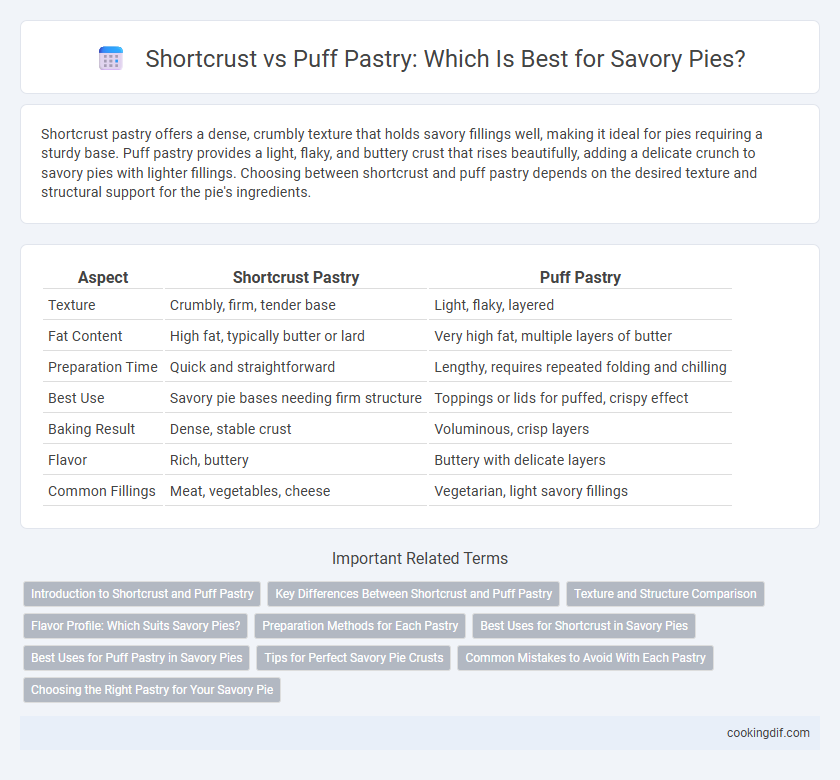Shortcrust pastry offers a dense, crumbly texture that holds savory fillings well, making it ideal for pies requiring a sturdy base. Puff pastry provides a light, flaky, and buttery crust that rises beautifully, adding a delicate crunch to savory pies with lighter fillings. Choosing between shortcrust and puff pastry depends on the desired texture and structural support for the pie's ingredients.
Table of Comparison
| Aspect | Shortcrust Pastry | Puff Pastry |
|---|---|---|
| Texture | Crumbly, firm, tender base | Light, flaky, layered |
| Fat Content | High fat, typically butter or lard | Very high fat, multiple layers of butter |
| Preparation Time | Quick and straightforward | Lengthy, requires repeated folding and chilling |
| Best Use | Savory pie bases needing firm structure | Toppings or lids for puffed, crispy effect |
| Baking Result | Dense, stable crust | Voluminous, crisp layers |
| Flavor | Rich, buttery | Buttery with delicate layers |
| Common Fillings | Meat, vegetables, cheese | Vegetarian, light savory fillings |
Introduction to Shortcrust and Puff Pastry
Shortcrust pastry is a dense, crumbly dough made from flour, fat, and water, ideal for savory pies requiring a sturdy base that holds fillings without becoming soggy. Puff pastry consists of numerous delicate layers created by folding and rolling dough with butter, resulting in a flaky, airy texture that offers a light contrast to rich, savory ingredients. Choosing between shortcrust and puff pastry depends on the desired structural stability and texture in the final savory pie.
Key Differences Between Shortcrust and Puff Pastry
Shortcrust pastry offers a dense, crumbly texture ideal for savory pies requiring a sturdy base, made primarily from flour, fat, and water without leavening. Puff pastry features multiple layers achieved by folding butter within dough, creating a flaky, airy texture that rises significantly during baking, making it perfect for lighter, crisp-topped pies. The key differences lie in texture, structure, and preparation technique, with shortcrust providing firmness and puff pastry emphasizing flakiness and lift.
Texture and Structure Comparison
Shortcrust pastry offers a dense, crumbly texture ideal for supporting heavier savory pie fillings, providing a sturdy base that resists sogginess. Puff pastry features multiple flaky layers created by repeated folding and butter incorporation, resulting in a light, airy structure that rises beautifully in the oven. The choice between shortcrust and puff pastry significantly impacts the pie's mouthfeel and structural integrity during baking and serving.
Flavor Profile: Which Suits Savory Pies?
Shortcrust pastry offers a rich, buttery flavor with a crumbly texture that complements hearty, savory fillings like meat or vegetable stews. Puff pastry provides a light, flaky, and airy texture with a subtle buttery taste, adding a crisp contrast to moist savory pie contents. For robust, dense fillings, shortcrust enhances the overall savoriness, while puff pastry suits lighter, delicate fillings where texture plays a key role.
Preparation Methods for Each Pastry
Shortcrust pastry involves mixing flour, fat, and a small amount of water to create a firm, crumbly dough that provides a sturdy base for savory pies. Puff pastry requires a meticulous process of layering butter and dough through repeated folding and rolling, producing a flaky, airy texture ideal for lighter toppings. The preparation method of shortcrust emphasizes simplicity and stability, while puff pastry demands precision and time for its characteristic rise and delicate layers.
Best Uses for Shortcrust in Savory Pies
Shortcrust pastry offers a firm, crumbly texture ideal for holding rich savory fillings such as meat, cheese, and vegetable pies without becoming soggy. Its buttery flavor complements hearty ingredients, making it the best choice for quiches, pot pies, and tarts where a sturdy base is essential. Unlike puff pastry, shortcrust provides a reliable structure that supports dense or wet fillings, ensuring a perfectly balanced savory pie.
Best Uses for Puff Pastry in Savory Pies
Puff pastry excels in savory pies requiring a light, flaky texture and dramatic volume, making it ideal for dishes like chicken pot pie, beef wellington, and vegetable tarts. Its multiple layers of butter and dough create a crisply puffed crust that adds rich flavor and an elegant appearance. Puff pastry's versatility supports both fully enclosed pies and decorative toppings, enhancing presentation without compromising firmness or moisture retention.
Tips for Perfect Savory Pie Crusts
For a perfect savory pie crust, choose shortcrust for a tender, crumbly texture that holds fillings well, and puff pastry for a light, flaky, and buttery layer that adds impressive height and crispiness. Keep all ingredients cold, especially butter, to prevent melting and ensure distinct flaky layers in puff pastry and a crumbly, melt-in-the-mouth finish in shortcrust. Avoid overworking the dough to maintain a tender crust, and bake with pie weights or docking techniques for even cooking and a crisp bottom.
Common Mistakes to Avoid With Each Pastry
Shortcrust pastry often suffers from overworking the dough, which leads to toughness instead of a crumbly texture ideal for savory pies. Puff pastry mistakes typically include inadequate chilling, causing the layers to merge and preventing proper puffing during baking. Avoiding improper handling and temperature control with both pastries ensures a flaky, tender crust that perfectly complements savory fillings.
Choosing the Right Pastry for Your Savory Pie
Shortcrust pastry offers a sturdy, crumbly base ideal for hearty savory pies with dense fillings, providing a balanced texture that holds up well during baking. Puff pastry, characterized by its flaky, layered structure, adds a light, buttery crunch, enhancing pies with delicate or saucy fillings. Selecting between shortcrust and puff pastry depends on the desired texture and filling consistency, ensuring the pastry complements the pie's flavor and structural requirements.
Shortcrust vs Puff Pastry for savory pies Infographic

 cookingdif.com
cookingdif.com